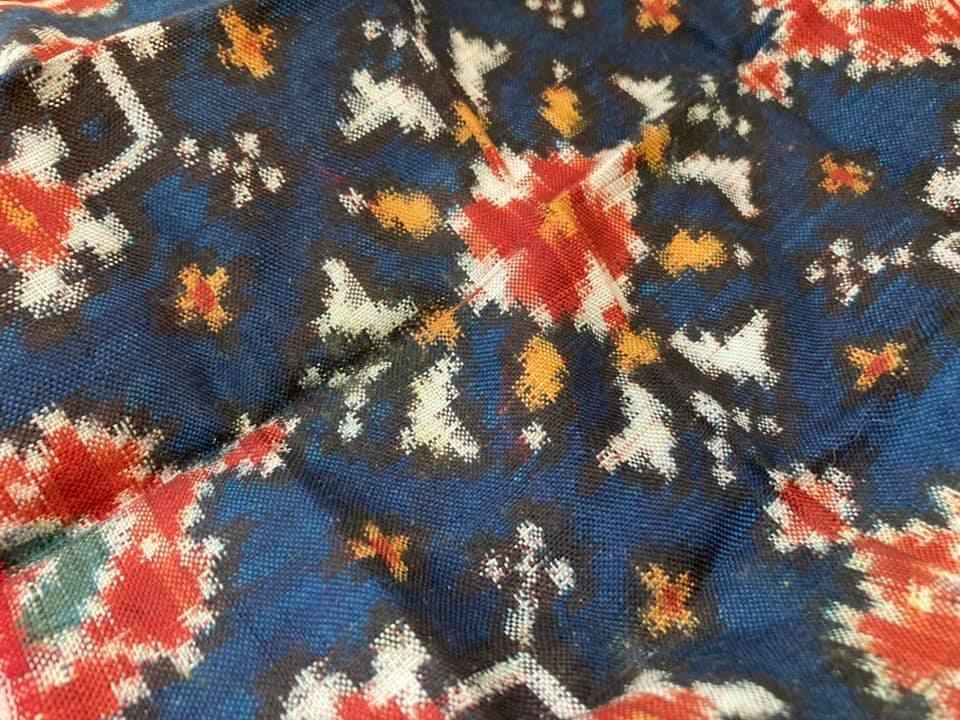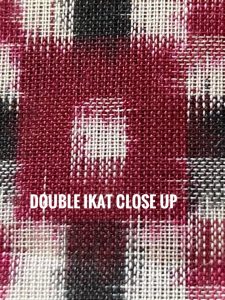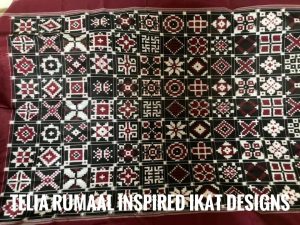
The word ‘ikat’ comes from the Malay-Indonesian word for ‘tie’
 It is one of the techniques of weaving that uses a resist dyeing process similar to tie-dye. It uses either the warp or weft to weave a pattern or design. When both warp ( length) and weft (breadth) are tie-dyed then it is called double Ikat.
It is one of the techniques of weaving that uses a resist dyeing process similar to tie-dye. It uses either the warp or weft to weave a pattern or design. When both warp ( length) and weft (breadth) are tie-dyed then it is called double Ikat.
The differences between warp ikat, weft ikat and double ikat depend on whether it is the warp or weft yarns that are dyed to create the chosen pattern.
Warp Ikat
In warp ikat, the weft yarns are all dyed a solid colour and only the warp yarns are pattern dyed. Here, the pattern is clearly visible when the threads are wound on the loom, and weaving in the weft threads solidifies the colour and completes the fabric formation.
Weft Ikat
In weft ikat, it is the weft threads that are pattern dyed. This type of weaving is more difficult than warp ikat, as the pattern will be formed only as the weaving progresses. This means that the weaver has to constantly centre and readjust the yarns to ensure the pattern is formed correctly.
Double Ikat
The most complicated of the three, double ikat, is where both the warp and weft threads are resist-dyed prior to weaving. This technique requires advanced skill, takes time and hence is the most expensive.
The most luxurious of the double ikats is the Patan Patola from Gujarat ( GI tagged) which deserves a separate article altogether.
The famous Telia Rumaal of Telangana is another stunning example of the complex double ikat. It must be noted that the ‘telia’ refers to a technique that is no longer in popular use so the correct description for what is available now would be ‘telia rumal inspired designs’ ( featured in image).
The ikats from Telangana follow geometrical patterns and the one featured here is a double ikat from Koyyalagudem, Telangana done on cotton in natural dyes.

How does one identify a double ikat?
 Look closely at the last image. Do you see how the coloured lines appear into the next colour from both sides- vertically as well as horizontally. This happens only in a double ikat where the dyed yarns of both warp and weft intersect.
Look closely at the last image. Do you see how the coloured lines appear into the next colour from both sides- vertically as well as horizontally. This happens only in a double ikat where the dyed yarns of both warp and weft intersect.
A close up also shows the blue and red yarns intersecting . Again, sign of a double ikat.
One does need hi tech equipment to see this. A magnifying glass or even a full zoom using your phone camera should do the trick.
Also featured in the image of the Patan Patola and the ‘bandha kala’ of Odisha featuring the idols of the Jagannath Temple at Puri.
Savitha Suri is a textile enthusiast and works in documenting textile history and traditions. She heads the WECCI – Maharashtra Handloom Councl.
email: pravaaha.communications@gmail.com




